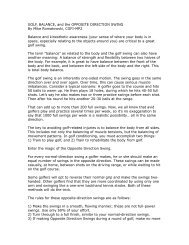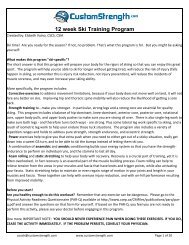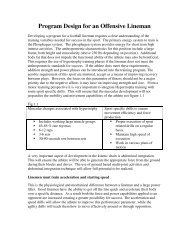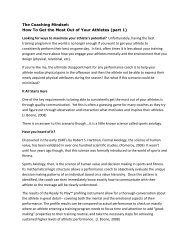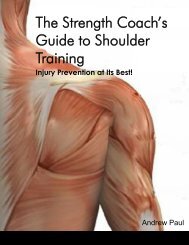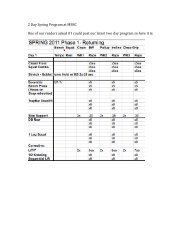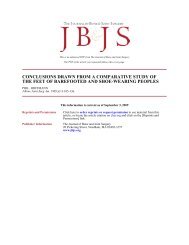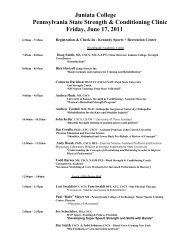Sprint Interval Training - “It's a HIIT - Strength Coach.com
Sprint Interval Training - “It's a HIIT - Strength Coach.com
Sprint Interval Training - “It's a HIIT - Strength Coach.com
Create successful ePaper yourself
Turn your PDF publications into a flip-book with our unique Google optimized e-Paper software.
time trials that required approximately two and 60 minutes to <strong>com</strong>plete. Additionally, similar increases were seen<br />
in muscle oxidative capacity, buffering capacity (ability to process lactic acid) and glycogen content (muscle fuel).<br />
While it is impressive that similar physiological and performance adaptations took place; despite a large difference<br />
in the training volume, I suspect that a time trial lasting only one minute may well have produced a better<br />
performance from the SIT group than the ET group because of the greater anaerobic contribution in an activity<br />
lasting one minute as <strong>com</strong>pared to two minutes. Either way, the study clearly demonstrates, again, the superior<br />
time efficiency of SIT to LMICT and that SIT is effective at improving the ability to perform LMICT when required. In<br />
a previous study from the same research group, it had been shown that a very similar SIT protocol elicited a<br />
twofold increase in cycle endurance capacity, measured as time to fatigue at 80% VO 2 max (an average of 26<br />
minutes pre training to an average of 51 minutes post training) 18 . This study by Burgomaster et al. further<br />
demonstrated that muscle oxidative potential, as measured by an increase in citrate synthase (CS) maximal activity<br />
(a marker for oxidative metabolism) increased 38% and resting muscle glycogen content increased by 26%, another<br />
benefit for improving performance. But the ability to double one’s endurance capacity in just two weeks utilizing<br />
only 16 minutes of SIT is worthy of some major publicity. While the results of the study did reach the media, the<br />
news was typically lost in the vast sea of “cardio” dogma. The study also brought to light a very important principle<br />
when it <strong>com</strong>es to SIT. Para et al. had previously shown an increase in muscle oxidative potential with daily SIT but<br />
without an improvement in anaerobic work capacity 19 . It was concluded that chronic fatigue may have contributed<br />
to the lack of an improvement in this important physiological parameter; however, the study by Burgomaster et al.<br />
was able to demonstrate an improvement in peak power output, a marker of anaerobic performance, while<br />
simultaneously improving endurance capacity using less training days and more rest days. So, when it <strong>com</strong>es to<br />
SIT, less can be more; so, focus on quality not quantity. I have long said, “inactivity is a bad thing but rest is a good<br />
thing and there is a big difference between the two.” It is during rest that the body adapts to the stress of exercise<br />
and it is particularly relevant when resting from SIT or <strong>HIIT</strong> where it has been shown that very short time periods of<br />
activity can have a significant physiological effect.<br />
There are a vast number of studies that lend considerable support to the argument that SIT, <strong>com</strong>pared to<br />
9



